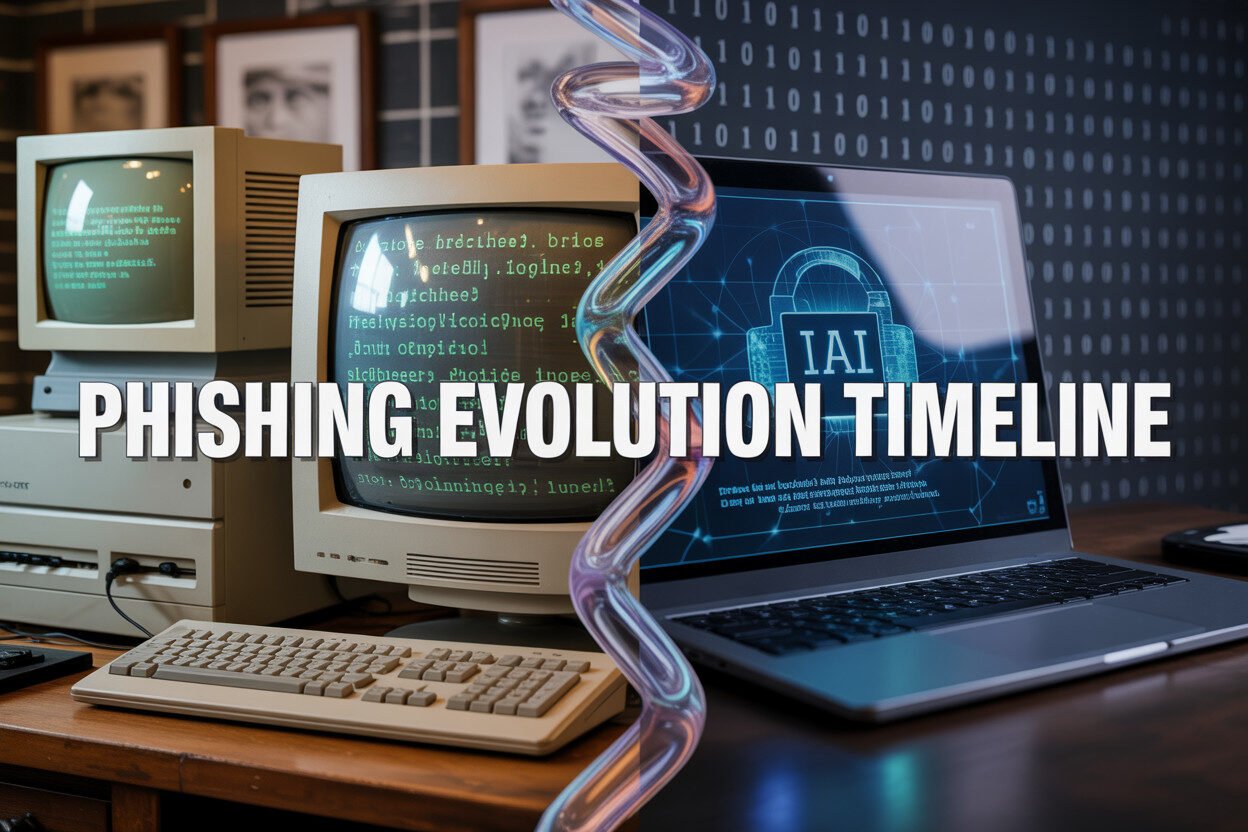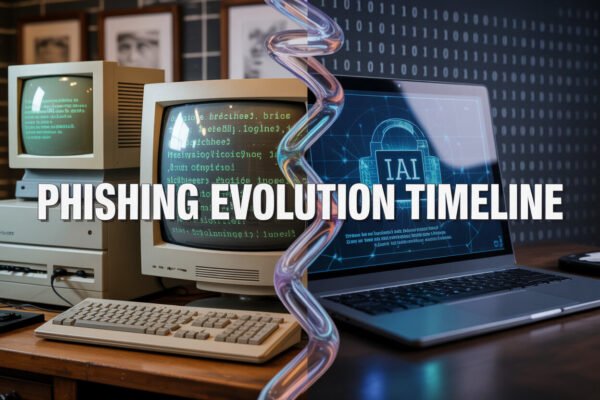Phishing attacks started as clumsy copy-paste schemes in the 1990s but have transformed into sophisticated AI-powered operations that threaten businesses worldwide. This evolution timeline is essential reading for IT professionals, security teams, and business leaders who need to understand how cybercriminals adapted their methods over three decades.
Cybercriminals today launch an estimated three billion phishing emails daily, with 91% of cyberattacks beginning with these deceptive messages. The phishing evolution shows a clear progression from simple AOL account theft to complex, personalized attacks that cost organizations millions. Understanding this phishing history helps explain why modern phishing methods remain the top cybersecurity threat.
We’ll explore how phishing attacks moved from basic credential theft in the 1990s to mainstream financial scams in the early 2000s, then evolved into organized cybercrime operations. You’ll discover how advanced phishing techniques emerged in the 2010s alongside political targeting, and see how today’s AI-powered attacks represent the latest phase in cybercrime timeline development. Each era brought new levels of phishing sophistication that security teams still battle today.
The Birth of Phishing in the 1990s

The Birth of Phishing in the 1990s
The mid-1990s marked the dawn of what would become one of the most persistent and damaging cybersecurity threats in history. As the internet began its transformation from a niche academic network to a mainstream communication platform, cybercriminals started developing the social engineering tactics that would define phishing attacks 1990s era and beyond.
AOL Users Become First Major Targets
America Online (AOL) dominated the internet landscape during this period, serving as the primary gateway for millions of users entering cyberspace through paid dial-up connections. This massive user base made AOL an irresistible target for early cybercriminals, particularly those within the underground “warez community” – hackers and software pirates who used the service to communicate and share pirated content.
The platform’s popularity, combined with users’ relative inexperience with online security threats, created the perfect storm for the first systematic phishing history attacks. AOL’s 30-day free trial system, distributed via floppy disks, attracted users seeking affordable internet access, but it also drew the attention of those looking to exploit the system for malicious purposes.
Credit Card Algorithm Scams and Account Takeovers
The earliest phishing techniques employed by these cybercriminals were surprisingly sophisticated for their time. These attackers developed a two-pronged approach that would lay the foundation for future cybercrime timeline developments. Initially, they focused on stealing legitimate user passwords while simultaneously using algorithms to generate randomized credit card numbers.
This systematic approach to fraud proved remarkably effective despite its seemingly random nature. While successful hits were relatively rare, the attackers struck the jackpot frequently enough to cause substantial damage across the platform. The randomly generated credit card numbers were strategically used to open new AOL accounts, which then served as launching points for spam campaigns and various other malicious activities.
AOL recognized the growing threat and implemented decisive countermeasures in 1995, creating robust security protocols specifically designed to prevent the successful use of randomly generated credit card numbers. This corporate response forced the cybercriminals to evolve their tactics, leading directly to the development of what would become the standard phishing playbook still used today.
Origins of the Term “Phishing” from Hacker Communities
With their initial credit card generation schemes effectively neutralized, these early cybercriminals pivoted to more direct social engineering approaches. They began crafting deceptive messages sent through AOL’s instant messenger and email systems, impersonating AOL employees and administrators to trick users into voluntarily surrendering their account credentials and billing information.
The term “phishing” itself emerged from this underground community, with its first recorded mention appearing on January 2, 1996, in a Usenet newsgroup called AOHell. This naming convention wasn’t accidental – the deliberate use of “ph” instead of “f” directly connected these scams to the established hacker subculture known as “phreaks,” who specialized in exploring and manipulating telecommunication systems.
The success of these early attacks stemmed largely from their novelty. Since nothing like these impersonation scams had ever been attempted before, unsuspecting AOL users had no framework for recognizing the deception. The attackers exploited this unfamiliarity ruthlessly, establishing the core principle that would define email phishing scams for decades to come: leveraging human trust and inexperience rather than technical vulnerabilities to achieve their malicious goals.
Early 2000s: Phishing Goes Mainstream

Early 2000s: Phishing Goes Mainstream
Now that we have covered phishing’s humble beginnings in the 1990s, the early 2000s marked a pivotal transformation in the phishing evolution timeline. This decade witnessed phishing attacks shift from simple pranks to sophisticated, financially-driven cybercrime operations that would reshape the digital threat landscape forever.
The proliferation of e-commerce platforms and online payment systems created an unprecedented opportunity for cybercriminals. As platforms like eBay and PayPal gained massive user bases, phishers recognized the potential for substantial financial gain beyond the simple account theft schemes of the previous decade. This period saw phishing attacks become more strategic, targeted, and devastatingly effective.
The ILOVEYOU Love Bug Attack of May 2000
The ILOVEYOU attack, which surfaced on May 4, 2000, represents one of the first major demonstrations of phishing’s mainstream potential. This malicious campaign spread across email systems worldwide when recipients received messages titled “ILOVEYOU” containing what appeared to be a harmless .txt file named LOVELETTER.
When users opened the attachment, expecting a romantic message, they instead unleashed a destructive worm that systematically overwrote image files on their computers. The malware’s most insidious feature was its ability to replicate itself by accessing the victim’s Outlook address book and sending copies to all contacts, creating an exponential spread pattern.
This attack demonstrated how social engineering techniques could be weaponized on a global scale. The seemingly innocent love letter preyed on human curiosity and emotion, making it irresistible to recipients who had no reason to suspect malicious intent. The ILOVEYOU worm infected millions of computers worldwide and caused billions of dollars in damage, marking a turning point where phishing attacks 1990s simplicity evolved into coordinated, large-scale operations.
First eCommerce Phishing on E-Gold Website
With this understanding of phishing’s growing sophistication, the first known phishing attack targeting eCommerce platforms occurred in June 2001 with the E-Gold website. This attack marked a significant milestone in the cybercrime timeline, as it represented the beginning of financially-motivated phishing campaigns targeting digital payment platforms.
E-Gold, an early digital currency service, became the testing ground for techniques that would later be refined and deployed against major financial institutions and payment processors. The attack demonstrated how cybercriminals could create convincing replicas of legitimate websites to harvest user credentials and financial information.
This pioneering eCommerce phishing attack established the blueprint for future campaigns: creating fake websites that closely mimicked legitimate services, crafting urgent email messages that compelled users to act quickly, and targeting platforms where users stored or transferred money. The success of this attack proved that online financial services were vulnerable to social engineering tactics.
Rise of PayPal and eBay Targeted Scams
Previously, phishing attacks had focused primarily on service providers like AOL, but the emergence of PayPal and eBay as dominant online platforms created new opportunities for cybercriminals. These platforms became prime targets due to their massive user bases and direct connection to users’ financial accounts.
PayPal phishing campaigns became particularly sophisticated and widespread during this period. Cybercriminals would send official-looking emails complete with PayPal logos and branding, claiming suspicious activity on user accounts or requesting identity verification to continue service access. These email phishing scams created a false sense of urgency, compelling users to click through to meticulously crafted fake PayPal websites.
The psychological manipulation was expertly executed – users, concerned about protecting their financial accounts, would willingly enter their login credentials on fraudulent sites. Within hours or days, victims would discover their accounts had been drained of funds. The effectiveness of these attacks was staggering, with cybercriminals successfully stealing millions of dollars from unsuspecting users.
eBay users faced similar threats, with phishers creating fake auction-related emails claiming issues with listings, payment problems, or account suspensions. These targeted scams exploited users’ dependence on these platforms for their online buying and selling activities.
Between May 2004 and May 2005 alone, approximately 1.2 million users in the United States suffered losses due to phishing attacks, with total damages reaching approximately $929 million. This massive financial impact demonstrated that phishing had evolved from a nuisance into a serious economic threat requiring immediate attention from both businesses and law enforcement agencies.
The success of these early 2000s campaigns established organized cybercrime as a lucrative industry and set the stage for the more advanced phishing techniques that would emerge in the following decades.
2000s Decade: Organized Cybercrime Emerges

2000s Decade: Organized Cybercrime Emerges
The transition from individual hackers to sophisticated criminal enterprises marked a pivotal decade in phishing evolution. Previously scattered attacks transformed into systematic operations as cybercriminals recognized the lucrative potential of organized fraud.
Specialized Software for Phishing Operations
With this criminal professionalization came the development of specialized tools designed specifically for phishing campaigns. By the mid-2000s, phishing was recognized as a fully organized part of the black market economy, complete with specialized groups providing dedicated phishing software and turnkey campaigns. These criminal organizations operated with business-like efficiency, offering comprehensive packages that included email templates, hosting services, and data harvesting tools.
The sophistication of these operations became evident in their targeting strategies. The first known direct attempt against a payment system occurred in June 2001 when cybercriminals targeted E-gold. Shortly after the September 11 attacks, attackers exploited national security concerns with “post-9/11 id check” phishing campaigns, demonstrating their ability to rapidly capitalize on current events and public anxieties.
Financial institutions became prime targets as criminals refined their techniques. The first known phishing attack against a retail bank was reported in September 2003, marking the beginning of sustained campaigns against the banking sector. By 2005, the UK banking sector experienced almost double the losses from web banking fraud compared to 2004, highlighting the escalating effectiveness of these organized efforts.
Bitcoin Launch Enables Anonymous Transactions
While Bitcoin wouldn’t officially launch until 2009, the groundwork for anonymous digital transactions was being laid during this decade, setting the stage for future cybercrime monetization. The emerging digital economy created new opportunities for criminals to obscure their financial trails and complicate law enforcement efforts.
$929 Million in Losses Across 1.2 Million Victims
The scale of organized phishing operations during this period reached unprecedented levels. Between May 2004 and May 2005, approximately 1.2 million computer users in the United States alone suffered losses totaling approximately $929 million from phishing attacks. This staggering figure demonstrated how organized cybercrime had evolved from opportunistic scams to systematic wealth extraction operations.
Geographic concentration of these criminal enterprises became increasingly apparent. In 2006, nearly half of all phishing thefts were attributed to groups operating through the Russian Business Network based in St. Petersburg, illustrating the international nature of organized cybercrime.
The criminals expanded their targeting beyond financial institutions to include government agencies and social platforms. Email scams posing as the IRS were used to steal sensitive data from U.S. taxpayers, while social networking sites became prime targets. By 2007, 3.6 million adults lost $3.2 billion due to phishing attacks, reflecting the criminals’ ability to adapt to new digital platforms and user behaviors.
This decade established the foundation for modern cybercrime organizations, transforming phishing from amateur copy-paste schemes into sophisticated, profit-driven enterprises that would continue evolving with technology.
2010s: Advanced Techniques and Political Targeting

2010s: Advanced Techniques and Political Targeting
The 2010s marked a pivotal shift in phishing evolution, transitioning from opportunistic financial scams to sophisticated, multi-layered cyber warfare. Previously concentrated on individual financial theft, phishing attacks now embraced advanced techniques that bypassed traditional security measures and targeted high-value political and corporate entities.
Ransomware Integration with Phishing Campaigns
During this decade, cybercriminals revolutionized their approach by integrating ransomware with traditional phishing methods. These hybrid attacks began with seemingly legitimate emails containing malicious attachments or links that, once clicked, installed ransomware onto victims’ systems. The sophistication of these campaigns marked a significant departure from simple credential harvesting, as attackers could now encrypt entire networks and demand substantial financial payments.
The ransomware-phishing combination proved devastatingly effective because it leveraged the trusted nature of email communication while delivering maximum financial impact. Organizations found themselves facing not just data theft but complete operational paralysis, forcing them to either pay substantial ransoms or rebuild their entire digital infrastructure.
High-Profile Political Attacks on Campaign Officials
With this evolution in mind, the 2010s witnessed unprecedented targeting of political figures and campaign officials. Spear-phishing attacks became increasingly personal and sophisticated, with attackers gathering extensive intelligence on their targets before crafting convincing messages. These attacks often appeared to come from colleagues, superiors, or trusted contacts within political organizations.
Campaign officials became prime targets due to their access to sensitive strategic information, donor databases, and confidential communications. The attackers employed social engineering techniques that went far beyond simple impersonation, incorporating detailed knowledge of ongoing political campaigns, personal relationships, and current events to create highly convincing deceptive messages.
HTTPS Adoption Creates False Security Perceptions
Now that HTTPS encryption became more widespread during this period, cybercriminals exploited users’ growing trust in the “secure” padlock icon. Many internet users began associating HTTPS with legitimate websites, creating a false sense of security that phishers readily exploited. Malicious actors started obtaining SSL certificates for their fraudulent sites, making their phishing pages appear authentic and trustworthy.
This development represented a critical shift in phishing sophistication, as attackers moved beyond simple visual mimicry to technical authentication spoofing. The presence of HTTPS encryption on phishing sites significantly increased their success rates, as users became less vigilant when they saw security indicators they had been trained to trust.
Human factors research from this era revealed that users were increasingly susceptible to these enhanced phishing techniques, particularly when multiple trust indicators were present simultaneously. The combination of professional design, HTTPS encryption, and targeted personal information created an almost perfect storm of deception that traditional security awareness training struggled to address effectively.
Modern Phishing Sophistication

Modern Phishing Sophistication
With organized cybercrime firmly established in the previous decade, modern phishing has evolved into an unprecedented level of sophistication that leverages cutting-edge technologies and advanced intelligence-gathering techniques. Today’s threat actors deploy multi-layered attack strategies that combine artificial intelligence, social engineering, and technical steganography to create highly targeted campaigns that bypass traditional security measures.
Social Media Intelligence Gathering for Spear Phishing
Modern attackers have transformed social media platforms into powerful reconnaissance tools for crafting highly personalized spear phishing attacks. These sophisticated campaigns leverage AI’s ability to analyze vast amounts of data scraping from multiple sources to create credible, trust-building narratives that are nearly indistinguishable from legitimate communications.
Contemporary threat actors systematically gather intelligence by scraping:
- Professional networks to understand organizational structures and identify key personnel
- Social media platforms to analyze relationships and communication patterns between colleagues
- Corporate websites to perfectly mimic official communication styles and branding
- Public records to add convincing personal details that establish credibility
This automated intelligence-gathering process enables attackers to create thousands of personalized phishing emails within seconds, each tailored to specific individuals based on their digital footprint. The sophistication extends beyond simple email impersonation, as attackers can now seamlessly switch between email, voice, and video communications while maintaining consistent impersonation throughout multi-channel attacks.
PowerShell and Image File Steganography Techniques
Now that we’ve covered the intelligence-gathering phase, advanced phishing campaigns employ sophisticated technical methods to deliver malicious payloads while evading detection. Modern attackers utilize PowerShell scripts embedded within seemingly innocent image files through steganography techniques, allowing malicious code to remain hidden within legitimate-looking attachments.
These campaigns often leverage Virtual Private Server (VPS) infrastructure to launch stealthy, scalable attacks that bypass geolocation-based defenses. VPS providers like Hyonix and Host Universal offer rapid setup with minimal open-source intelligence footprint, making detection extremely difficult for traditional security systems.
The technical sophistication includes:
- Domain fluxing tactics involving frequent changes in IP resolution to maintain resilient infrastructure
- Obfuscated inbox rules with minimal or generic names to avoid detection during automated audits
- Session hijacking techniques that enable simultaneous logins from both familiar and rare sources
- Multi-Factor Authentication bypass methods using token claims to maintain persistent access
91% of Cyberattacks Now Start with Phishing Emails
With this technical sophistication in mind, the scale and impact of modern phishing threats have reached critical levels, with phishing emails serving as the primary attack vector for the vast majority of successful cyberattacks. This statistic underscores how phishing has evolved from simple copy-paste scams into the foundation of nearly all cybercriminal operations.
The current threat landscape demonstrates that traditional phishing kits remain popular among cybercriminals because they offer proven effectiveness with low risk and minimal technical requirements. However, the economic model driving cybercrime is shifting as AI tools become more accessible and their success rates continue to improve.
Modern phishing sophistication manifests through:
- Multi-channel deception capabilities combining email, voice synthesis, and deepfake video technology
- Real-time adaptive strategies that modify attack approaches based on user interactions
- Automated social engineering deployed at unprecedented scale with minimal human intervention
- Contextually aware communications that perfectly mimic legitimate organizational tone and style
Despite the rise of AI-enhanced phishing threats, analysis of 386,000 malicious phishing emails reveals that only 0.7% to 4.7% were actually crafted entirely by artificial intelligence. However, this relatively small percentage represents a rapidly evolving threat that’s becoming more sophisticated daily, suggesting we may be witnessing the calm before a much larger storm of AI-driven phishing attacks.
Current Scale and Impact of Phishing Threats

Current Scale and Impact of Phishing Threats
Now that we have explored the evolution of modern phishing sophistication, it’s crucial to understand the staggering scale and devastating impact these threats have reached in today’s digital landscape. The current phishing threat environment represents an unprecedented challenge for organizations and individuals worldwide.
Three Billion Phishing Emails Sent Daily
The sheer volume of phishing attacks in 2025 is staggering. An estimated 3.4 billion phishing emails are sent daily, accounting for 1.2% of global email traffic. This means that 1 in every 412 emails globally is a phishing attempt, creating an overwhelming challenge for cybersecurity professionals.
The frequency of these attacks has intensified dramatically, with 57% of organizations now facing phishing scams weekly or daily. This constant barrage means that employees in a typical 1,000-person company face approximately 2,330 phishing attacks per year, with roughly 466 of these attempts being clicked by unsuspecting users.
The evolution of phishing sophistication has contributed to this massive scale. Approximately 80% of phishing websites now feature HTTPS encryption, combined with AI obfuscation techniques like invisible characters and redirects. This technological advancement has led to a 47.3% increase in phishing emails bypassing traditional email gateways, making detection increasingly difficult.
One Million Attacks Recorded in Single Quarter
The Anti-Phishing Working Group (APWG) recorded 963,994 phishing attacks in Q1 2024 alone, demonstrating the massive scale of coordinated phishing operations. While this represents a decline from the 1,624,144 attacks recorded in Q1 2023, the sophistication and targeting precision of attacks has increased significantly.
These quarterly attack volumes highlight several concerning trends. The IC3 received 300,487 phishing reports in 2024, representing a tenfold increase since 2018. Meanwhile, phishing sites have proliferated from 110,554 in October 2019 to 1,023,579 in September 2024, marking an 11% rise from 2023.
The modern phishing landscape has evolved beyond simple volume-based attacks. Phishing attacks have doubled in frequency since the COVID-19 pandemic, with targeted attacks becoming more prevalent even as overall global phishing volume dropped 20% compared to the previous year.
Major Corporate Victims Including Google and Facebook
The impact of modern phishing extends to major corporations, with over 44,750 attacks specifically targeting Facebook in the past year alone. These sophisticated campaigns demonstrate how cybercriminals now focus on high-value targets and brand impersonation strategies.
The financial consequences are severe. Phishing-related data breaches involving 10 million exposed records cost an average of $50 million, while the average cost of a phishing breach reached $4.88 million in 2024, representing a 9.7% increase from 2023. The global cost of phishing could reach $250 billion in 2024, up from $147 billion in 2021.
Phishing attacks cost businesses an average of $200,000 per event, with Business Email Compromise (BEC) losses alone totaling $6.3 billion. These attacks contribute to 80% of security incidents, with losses accumulating at $17,700 every minute due to phishing attacks. The human element remains critical, as human error contributes to 60% of security breaches, with 45% of ransomware attacks initiated through phishing emails.
Conclusion
The evolution of phishing from simple AOL scams in the 1990s to today’s AI-powered attacks reveals a disturbing pattern: as our digital defenses improve, cybercriminals adapt with increasingly sophisticated methods. What began as crude attempts to steal free internet access has transformed into a trillion-dollar criminal enterprise that serves as the gateway for 91% of all cyberattacks. From the early copy-paste emails targeting AOL users to modern spear-phishing campaigns leveraging social media intelligence and advanced evasion techniques, phishers have consistently stayed one step ahead by exploiting the weakest link in any security system—human psychology.
With three billion phishing emails sent daily and attacks reaching unprecedented levels, the threat landscape will only intensify as artificial intelligence becomes more accessible to criminals. Organizations can no longer rely solely on technological solutions to combat these evolving threats. The most effective defense strategy combines advanced email security tools with comprehensive employee training that transforms workers into human sensors capable of detecting and reporting suspicious activity. As phishing continues to evolve, so must our approach to defending against it—making cybersecurity awareness and rapid threat reporting not just IT priorities, but essential business competencies for every employee.
The evolution of phishing from simple AOL scams in the 1990s to today’s AI-powered attacks reveals a disturbing pattern: as our digital defenses improve, cybercriminals adapt with increasingly sophisticated methods. What began as crude attempts to steal free internet access has transformed into a trillion-dollar criminal enterprise that serves as the gateway for 91% of all cyberattacks. From the early copy-paste emails targeting AOL users to modern spear-phishing campaigns leveraging social media intelligence and advanced evasion techniques, phishers have consistently stayed one step ahead by exploiting the weakest link in any security system—human psychology.
With three billion phishing emails sent daily and attacks reaching unprecedented levels, the threat landscape will only intensify as artificial intelligence becomes more accessible to criminals. Organizations can no longer rely solely on technological solutions to combat these evolving threats. The most effective defense strategy combines advanced email security tools with comprehensive employee training that transforms workers into human sensors capable of detecting and reporting suspicious activity. As phishing continues to evolve, so must our approach to defending against it—making cybersecurity awareness and rapid threat reporting not just IT priorities, but essential business competencies for every employee.




